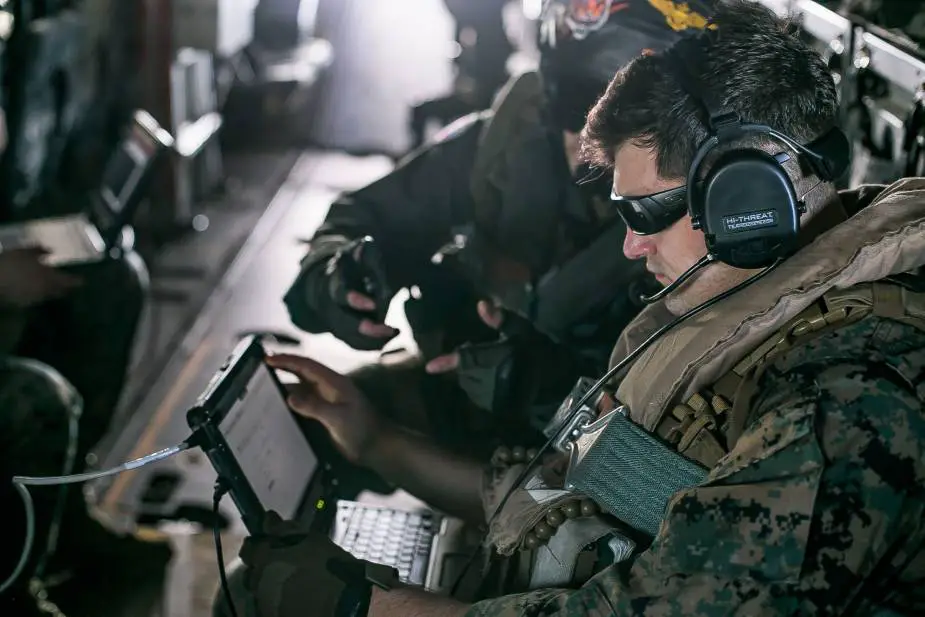The U.S. Marine Corps Systems Command is acquiring innovative command and control capabilities that increase mobility and communication on the battlefield to support the future fight. The Marine Corps considers Networking On-the-Move a significant capability in meeting this objective. Matt Gonzales, U.S. Marine Corps Systems Command, reports.
Follow Army Recognition on Google News at this link

Cpl. Clayton A. Phillips, a network administrator with U.S. 31st Marine Expeditionary Unit, tests the connectivity of Networking On-the-Move Airborne during flight operations from the amphibious assault ship, USS America. NOTM, a critical Force Design 2030 capability, is a mobile, satellite communication system that allows Marines to connect to networks and communicate while mobile or stationary on the battlefield. (Picture source: U.S. Marine Corps)
Fielded in 2013, NOTM is a mobile, satellite communication system that allows Marines to connect to networks and communicate while mobile or stationary on the battlefield. The capability enables command and control flexibility in various environments around the globe. “In laymen's terms, NOTM is similar to your phone when you’re driving around in your vehicle,” said Lt. Col. Austin Bonner, MCSC’s program manager for Command and Control Systems. “It’s giving you access to the internet—the services and applications you want to use while you’re on the go.”
U.S. Marines can employ NOTM to transmit critical information to commanders and increase situational awareness in hostile environments. The mobile system enables Marine leaders to control their forces and support the warfighter from anywhere on the globe. The capability comprises two variants: NOTM Ground Combat Vehicle and NOTM Airborne.
Marines can incorporate the ground version into systems such as the Joint Light Tactical Vehicle and Utility Task Vehicle. The Marine Corps also has plans to install NOTM-GCV onto the Amphibious Combat Vehicle and the Advanced Reconnaissance Vehicle in the future.
Marines can use the air variant on aircraft platforms such as the MV-22 Osprey and KC-130 tanker aircraft. NOTM Air enables them to provide critical information communication to a command post while en route to a given destination.
Meeting Force Design 2030
In August 2021, 3rd Marine Regiment and Marine Medium Tiltrotor Squadron 268 at Marine Corps Base Hawaii tested NOTM Air on an MV-22 Osprey to grow familiar with the system. Marines integrated the satellite system onto a prototype Utility Task Vehicle and wheeled it onto aircraft to display its mobility and transportability. It was the first time these groups have used NOTM on an aircraft. “Networking On-the-Move is an incredible capability that provides airborne access to information that is otherwise inaccessible,” said Maj. Christopher Montgomery, the aircraft maintenance officer with VMM-268.
Before this capability, Marines primarily communicated using radios while stationary. They would often sit static for long durations of time to collect data needed to visualize the current operational environment, said Bonner.
NOTM provides mobility they previously did not have. First Lt. Philippe Bergeron, of 1st Battalion, 3rd Marines, tested NOTM during Island Marauder 21. He applauded the system for its ability to provide internet services to commanders. “NOTM provides services to the commander while on the move, so there's no gap in communication,” said Bergeron. “This system enhances a commander's ability to receive updates or to track subordinate units.”
Commandant of the Marine Corps Gen. David Berger considers NOTM a key capability in meeting future service-wide goals, as stated in Force Design 2030. A critical goal for the Marine Corps is to acquire next-generation capabilities that support a concept called Expeditionary Advanced Base Operations.
EABO espouses the employment of systems that increase mobility and communication on a future battlefield around the globe. Increased mobility and communication are pillar characteristics of NOTM, as it enables Marines to maintain command and control while stationary or on the move, said Bonner.
NOTM will also support a new Marine Corps concept called Stand-in Forces, which explains how Marines can operate effectively with allies and partners from within a contested area. The concept describes how forward-postured, steady-state forces operating in contested areas while remaining capable of transitioning rapidly from competition to crisis to conflict and back again.
“NOTM is a critical capability for Force Design 2030 primarily because the system supports new concepts that are driving Marines to be more distributed, more displaced, less of a static command post,” said Bonner. “It gives Marines increased flexibility across multiple domains.”














